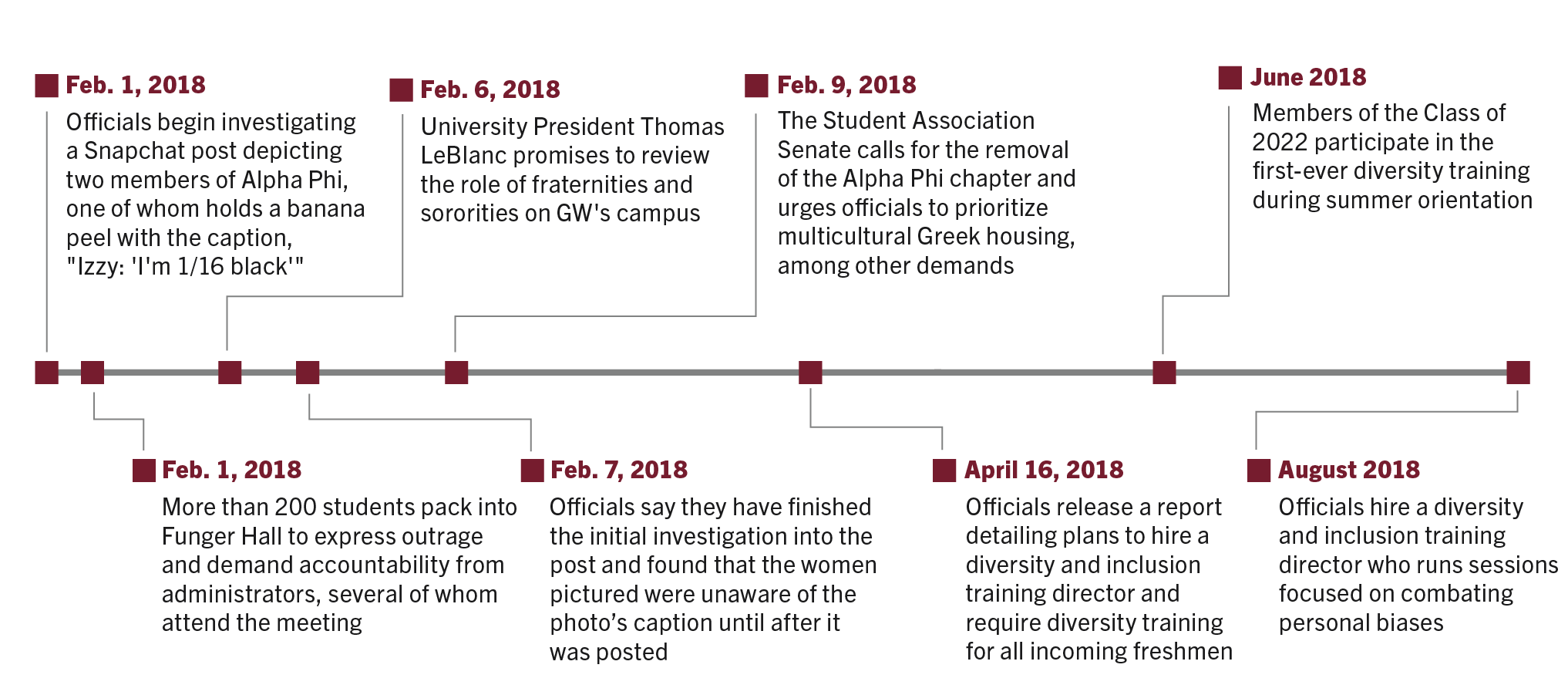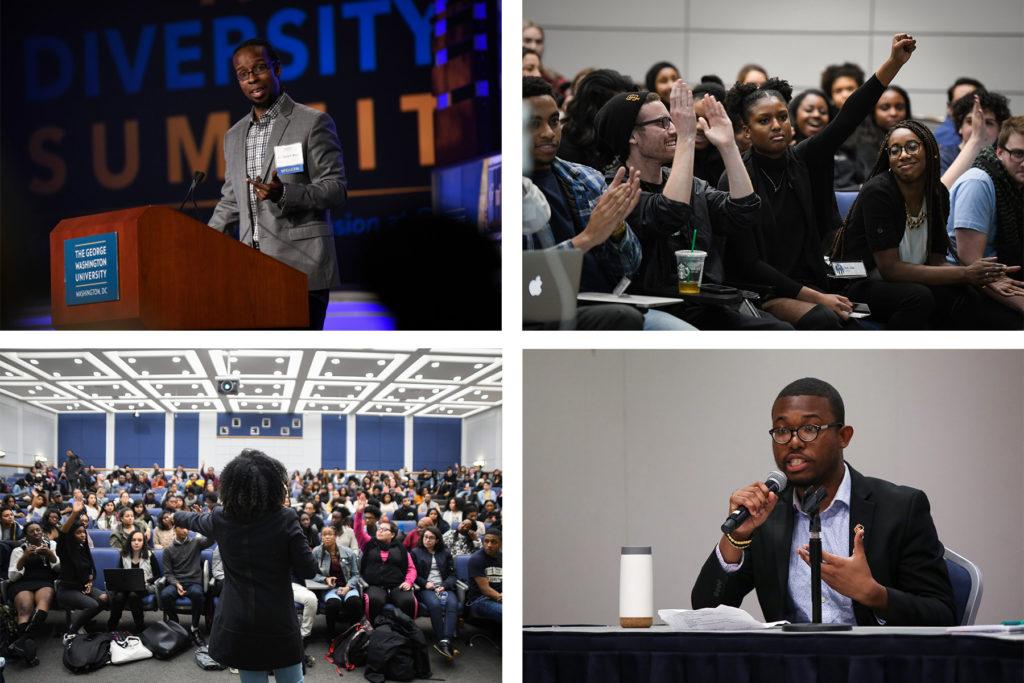One year ago, thousands of students woke up on the first day of Black History Month to a Snapchat post that would define GW’s diversity and inclusion efforts for months to come.
The post depicted two members of Alpha Phi, one of whom held a banana peel, with the caption, “Izzy: ‘I’m 1/16 black’” – which officials and students alike instantly condemned as racist. Over the next week and change, hundreds of students gathered twice in Funger Hall to call for the chapter’s removal and mandatory diversity training, while officials said the post wasn’t surprising and promised to implement a slew of new diversity initiatives.
At the same time, students and administrators questioned the role and inclusivity of sororities and fraternities at GW. The Panhellenic Association apologized for the post the same day it made rounds on campus, and Alpha Phi released a statement the next day saying it would throw out the three members involved in the post – but The Hatchet could not confirm that those students were removed after leaders of the sorority did not return multiple requests for comment.
Over the next several months, officials recruited 88 students, faculty and staff to contribute to a 12-page report outlining a nine-point plan to improve diversity and inclusion at GW. The demands included hiring a diversity and inclusion training director, hosting a new Race in America speaker series and requiring diversity training for freshmen, Greek life leaders and staff members who work closely with students.
Diversity and inclusion also dominated student leaders’ platforms in the weeks leading up to last year’s Student Association election.
Now, after a year of changes, black students said the post offered them a platform to unmask racism on campus and demand that officials implement measures to help shift campus culture. They said the post helped band the black community together and move past the incident with a stronger, more unified voice.
“We’re starting to talk about issues that affect us and trying to make changes on those issues rather than dwell on the past,” junior Michael Ferrier, the president of the Black Student Union, said. “Alpha Phi is over – it’s time to look forward.”

Emily Recko | Graphics Editor
A year of strength
Junior Simone Hunter-Hobson said that while students should not forget the incident, the black community is “not going to let this incident hold us down” as students focus on other projects, like planning the Black Heritage Celebration this month.
Hunter-Hobson, the president of the recently relaunched National Pan-Hellenic Council – which oversees six historically black Greek-letter chapters – said she is focusing her energy on “serving the black community in any way possible” through community service and fundraising events to support the chapters.
“We have our own council, we can make our own decisions, we conduct our own meetings,” she said. “Being able to unite as black students and do good work for the community – I think that’s my role.”
Sophomore Kahleel Hester, the president of GW Posse – the student arm of the Posse Foundation, which recruits high-achieving racially, economically and geographically diverse students from Atlanta – said GW has taken a step in “the right direction” but needs to take a “leap.”
Hester commended the University for enrolling more black students this year – with about 870 undergraduates this year compared to 790 last year, according to institutional data – but noted that the group is one of the only minority populations that does not have at least 1,000 students on campus.
“We’re not going to be at a school where we’re about to associate ourselves with bigotry,” he said. “I don’t think it will ever end, but we need to find a way to just acknowledge it and just prevent it.”
Ferrier, the BSU president, said the organization is focusing on bringing students together with town halls and events that “integrate” the black student community. Several top administrators attended a BSU town hall last November for members of the black community to discuss issues like a lack of faculty diversity and the Snapchat incident.
Dozens of black student leaders championed the community in the weeks following the Snapchat incident and were involved in shaping the University’s diversity and inclusion initiatives. The Hatchet reached out to 33 current and former black student leaders while reporting this story, but 17 declined to comment and 11 did not return multiple requests for comment.
A year of reform
So far, officials have met seven of the nine goals they outlined last spring – including implementing diversity training during first-year orientation and updating the student code of conduct to change the way discriminatory behavior is classified. Officials have two incomplete tasks: opening up options for more multicultural housing and finalizing pending revisions to the University’s equal opportunity policy.
Caroline Laguerre-Brown, the vice provost for diversity, equity and community engagement, said the action plan released last fall is “just a start” to the University’s diversity and inclusion initiatives. Officials will also launch an online education module about diversity and inclusion for incoming students, she said.
She added that a bias incident reporting system included in last year’s report is currently being tested.
“We still have more work to do, and I appreciate the efforts being made by so many of our students, faculty and staff,” she said in an email.
Jordan West took over as the inaugural diversity and inclusion education director last semester and has since hosted workshops for students, officials and faculty to combat implicit biases and discrimination.
The University also invited its first two speakers for the Race in America series last spring. Laguerre-Brown added that the Diversity Summit, held in the fall for the first time last semester, featured more than 20 educational sessions with students, faculty, staff and a keynote speech with journalist Jemele Hill.
Former Panhellenic Association President Elizabeth Jessup, who led the organization during the incident, said that after the Snapchat post, the association created a vice president of membership development position in December to make the Greek life community more inclusive.
She said Michael Tapscott, the director of the Multicultural Student Services Center, also facilitated a diversity training before recruitment for recruitment chairs and pi rho chis, members of sororities who temporarily disaffiliate from their chapters to guide students through recruitment.
“We’ve been doing the deep learning and work required to develop long-term initiatives to better our community and our members,” Jessup said in an email.
Hannah Blandon, the Panhellenic Association’s first vice president of membership development, said officials responded to the incident “without many students’ feelings or input in mind.” Blandon, who served on one of the University task forces to implement freshman diversity training, said few students have had clear communication with officials about the status of each initiative.
“Students haven’t gotten over it, myself included,” she said in an email. “It’s one of the reasons why I won’t stop pushing for diversity and inclusion education even though I know it won’t be the end-all-be-all for correcting institutional racism and prejudice.”
In her current position, Blandon said she is working with members of the MSSC to plan diversity and inclusion training for chapter leaders and interested members this semester.
The current president of Alpha Phi and representatives for Alpha Phi’s international organization did not return multiple requests for comment. Emma Montag, the former president of Alpha Phi, and the three women involved with the post – the two pictured and the third who posted and captioned the photo – also did not return multiple requests for comment.
A year of advocacy
Former SA President Peak Sen Chua, who led the student body during the incident, said that prior to the post, he and other student leaders had discussed diversity training but it was difficult to prove to officials that the initiative was needed. He said the incident and the SA’s resolution condemning the post “mobilized a response” from officials.
“The incident showed the University how much students really cared about it, how much it really hurt people,” Chua said. “They might have not realized that if this incident hadn’t happened, unfortunately.”
Senior Imani Ross, a former SA senator who spearheaded the legislation condemning the post, said officials should be more proactive in preventing racist incidents and “anticipate the next set of issues” before they arise.
“Cleaning up this mess was just the beginning to a long, systematic disenfranchisement of black and brown students,” she said in an email. “If administrators and students are serious about doing this work, it absolutely shouldn’t end here.”
SA Executive Vice President Ojani Walthrust, who was inspired to run after the incident, said that over the past year, the SA has created a diversity and inclusion assembly that helped ensure that student leaders could “hear out problems” from different communities. The assembly will wrap up its series of town halls for different minority groups at the end of the semester, he said.
He added that any administrative plans to improve diversity must be communicated through forums and meetings with students to ensure everyone is aware of the steps officials are taking to meet their concerns.
“Through all tough experiences, we have to make sure we see what happened and we prepare for it in the future to ensure that does not happen again,” he said.




